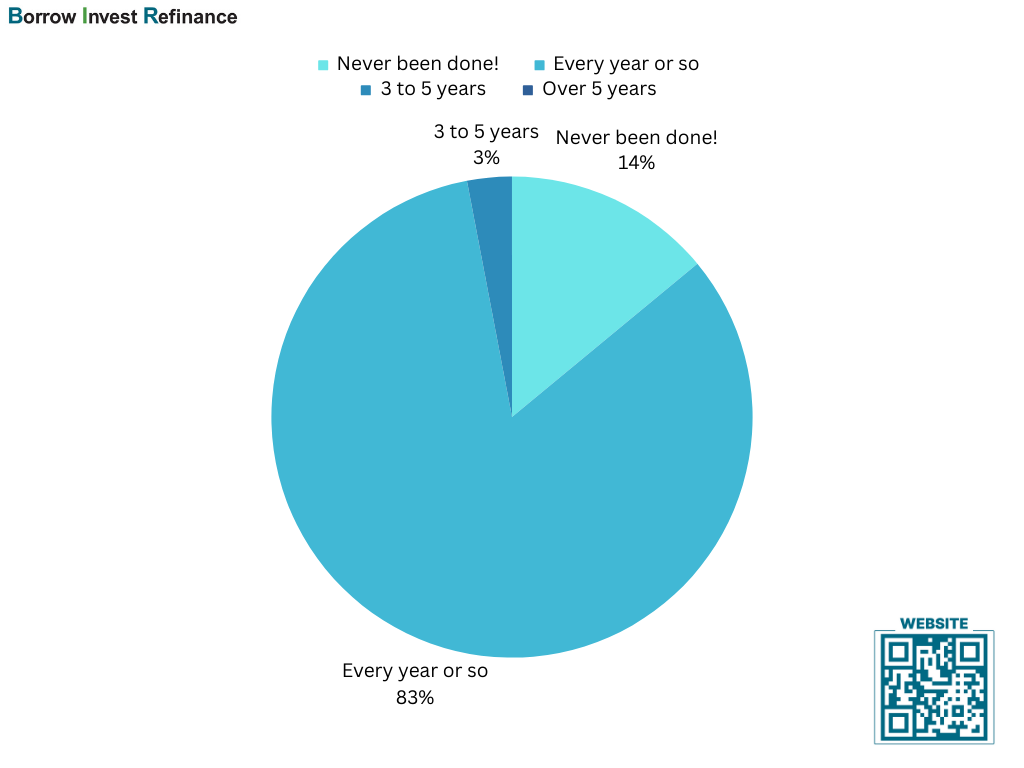Check the 2024 rental market trends below!
Well, Christmas is over, Santa has gone back to hibernation, and January’s wet, hot and sometimes wild weather is now a memory. And, the kids are back at school so all the iPads and Nintendos can take a well-earned break 💓
PLUS, our website feels much better after its summer cleansing and is good to go for all the information you need. 👍
Below are the results of the poll we posted on social media about updating your website. (We are clearly not the only slackers when it comes to doing regular website updates 😌)
This is a BUMPER edition to kick off the year.
As we roll into the new year, here’s what’s making news in property and finance.
- Property prices continue to surge
- Rental growth slowing
- Car loans rise 17.6%
- How to save more in 2024
- When to refinance
Read more below.
But first, here is some of our lovely stuff for you to enjoy!
Business survey results for 2024 – planning ahead
There is no need for me to comment – just go straight to the link below for a commentary as reported by Prospa.
Client stories (three quickies):
Retired and wealthy – refinancing investment properties
A client I have known for years in a number of capacities recently wanted to refinance his loans on two of his 4 investment properties (the other properties have no debt and nor does his home – lucky chappy!)
Getting a loan for someone who is 70 was relatively easy once we got all his income details on file.
To get the best rate, we used properties with a higher value as security so the LVR (Loan to Value Ratio) was below 60% and this gave him the best rate available.
Refinancing with an equity release loan – no questions asked
Two years ago, we found for our client obtained a great refinance deal plus a $300,000 equity release loan. so they could buy their son an apartment in the city They loved us so much he gave us a 5-star Google review 👍
Fast foward to 2023 and they wanted an additional cash-out loan of $250,000 to do up their investment properties.
Only one lender was showing them they could service this loan. We got them a great refinance deal including the additional $250,000, no questions asked.
To get them this additional borrowing and a great rate, the lender required a cross-collateralised loan across three of their properties. We did a few other nifty things to make sure the deal was a sharp one and given there was only one lender who would ‘do the deal’, it was a great result for our clients.
From ‘I’m in real trouble’ …. to ‘private equity’ …. to ‘lo doc’ …. next step Mars!
It was 2022. A self-employed client was going through a messy divorce. The only lender who would refinance his overdue and in-default home loan with a really poor credit rating, was a private lender.
Twelve months later: we moved our client from the private lender to a lo doc lender and reduced the rate by a couple of percent. This lo doc lender had a really friendly accountant’s declaration letter – one of the best I have seen. So that kept the client’s acccountant happy.
Touch wood, in one to two years, our client will have his financials in such a pristine and profitable condition that we will be able to move him to a low interest rate full doc loan.
Our latest survey results are in!
How often do you do a review and/or update your website?

First, a shout-out to Cecilia Timm for doing the website tidy-up – all done in a week. A lovely person is Cecilia, and thanks to Charli Van Essen, who recommended Cecilia to us. Charli is a value-for-money ace at Zoho and integrations, and she works with Jo McClure’s JM Virtual Business Services.
Cecilia’s brief was to get our website’s performance from an F to an A speed-wise – plus apply a bit of lipstick and mascara. Let us know what you think.
> Websites are tricky beasts.
A website can eat up a lot of time and money and sometimes it is difficult to know whether this investment actually pays a dividend.
The short answer is no one really knows, But. the good news is you can run analytics on your website to see how it is performing both from a performance perspective as well as a gravity-pulling perspective.
> Most of us treat our website as an e-brochure and not as a lead magnet
I don’t have statistics to support this comment but I reckon if you are updating your website every year or so, you are treating it as a brochure and not as a lead magnet.
This supports my anecdotal observations that many of us who have small businesses consider our websites to be a credibility brochure to confirm we are not a fly-by-night operation. I know I have been guilty of this (even today 🙏)
However, if you can direct it to be a quasi-lead magnet as well as a brochure, then most small business owners would be happy with that if this could be done at a low cost.
Web designers would, of course, say, ‘You get what you pay for,’ and they are probably right!
> Some people keep their hands in their pocket (when it comes to website expenditure)
It was a surprise but not a surprise that 17% of responders basically do nothing with their websites. I am sure even their paper-based brochures get more regular touch-ups than this!
> Some quick low-hanging fruit
- Make contacting you easy – by phone, email or making an appointment – make these connection points really clear on every page
- Keep the messaging simple – who do you help and what problem do you solve?
- If you can’t write (or more importantly, don’t have the time to write) and you can’t afford a copywriter, run what you want to say through ChatGPT. This is a seriously good resource. These days, I use it every day. it converts my dictated ramblings into pristine and succinct observations.
Property Clock Update!

Hey investors, the market’s getting hotter!
Don’t miss out on this amazing chance spanning over 30 regions in Australia. The reports we’ve got for you are top-notch, giving you all the info you need. Make sure to check them out before deciding on your next property investment.
Quick heads up: Your biggest loss could be Opportunity Cost.
When it comes to your upcoming property purchase, choosing the wrong one could cost you big time.
For instance, a 2% annual return difference (5% versus 7%) on a $500K property investment means you’re looking at a $63K drop in capital gain over 5 years and $179K over 10 years.
The solution?
Get in touch with a reliable property investment advisor. We’ve got connections to advisors who offer tailored, well-researched options to suit your needs.
Here’s the scoop on what’s been happening in the Regional Property Reports for the past three months:


As regular readers of my newsletters would know, the surge in property prices was not unexpected.
The inflationary cycle which leads to property price increases
Simply put, Inflation leads to higher interest rates, which leads to bigger bank profits, which leads to more money to lend, which leads to an upward push on property prices. Voila!
Per Phillip Anderson, a guy I follow and respect, 9 of the last 10 rate cycle increases resulted in an increase in property prices (not a decrease as some bank economists stated in the mainstream media were predicting).
So, with probably a couple of years left to run on the current property cycle uptick (courtesy of Phillip Anderson’s 18.6 year cycle), it is now time to….
See where we are in December 2023
Let’s have a quick look at where the market sits per the property research sourced by Michael Yardley.

The data is pretty self-explanatory, so no detailed comments from me, but it is interesting to note the timing of the most recent Peaks and Troughs. Melbourne is a bit of an outlier in terms of the most recent peak being December 2021 while Sydney, Brisbane, Adelaide and Perth have hit new highs in December 2023.

Domain data has revealed that rents grew strongly in 2023 but eased significantly in the final quarter of the year, potentially heralding a slowdown in rental growth for 2024.
Overall Rental Growth in 2023: Rents experienced strong growth throughout 2023, indicating a buoyant rental market for most of the year.
Annual Increase: There was a significant increase in the median house rent, which rose by 9.1% between the December quarters of 2022 and 2023.
Quarterly Stagnation: However, in the December quarter of 2023, there was no growth in house rents, marking a noticeable change from the previous trend. This stagnation could signal a potential shift in the market.
Unit Rent Trends:
Annual Growth: The median unit rent saw a substantial annual growth of 20.0%, which is notably higher than that for houses.
Moderate Quarterly Growth: In contrast to house rents, unit rents still grew in the December quarter, but the growth was much more moderate at 0.8%.
End of a Growth Streak: The data marks the end of a record-breaking sequence of 10 consecutive quarterly rent increases, suggesting a possible cooling down in the rental market as we move into 2024.
This information is crucial for stakeholders in the real estate market, including investors, renters, and policymakers, as it highlights a potential shift in market dynamics. The deceleration in rent growth, especially for houses, might indicate a more balanced market in the near future. However, the continued albeit slower growth in unit rents suggests ongoing demand in this segment. It will be interesting to observe how these trends evolve in 2024.

Domain’s Chief of Research and Economics, Nicola Powell, said that while the rental market remained tight, conditions appeared to be easing.
Rents were likely to increase in 2024, but at a slower rate than 2023, she added.
“Ultimately, rents couldn’t continue rising at the pace that they were and the pace that we were seeing particularly in 2022 and the early parts of 2023 and I think it showcases that that wasn’t sustainable for the longer term,” she said.
Dr Powell also said that the combination of government housing incentives and potentially lower interest rates might bring more first home buyers into the market, thereby reducing tenant numbers and rental competition.

Over the past year, Australia has witnessed notable growth in both the automotive and housing sectors.
The Australian Bureau of Statistics reports that in November 2023, Australians secured loans totalling $1.37 billion for road vehicle purchases. This figure represents a substantial 17.6% increase compared to the previous year. This rise in borrowing correlates with the record-breaking sales of new vehicles, as evidenced by data from the Federal Chamber of Automotive Industries, which shows that a staggering 1,216,780 new vehicles were purchased last year.
This trend in car buying is part of a broader surge in economic activity within key sectors, including the housing market, indicating a period of robust consumer spending and market confidence in Australia.

In the same period, there was a significant uptick in the Australian housing loan sector.
November saw consumers taking on $27.58 billion in new home loans, marking a 13.1% increase compared to the same month in the previous year. This substantial growth in new home loans was primarily driven by a surge in investor borrowing, which rose by 18.0%. However, borrowing by owner-occupiers was not far behind, registering a strong increase of 10.6%.
Contrastingly, the refinancing sector did not follow this upward trend.
In November, the value of home loans refinanced to new lenders amounted to $17.49 billion, which is a decline of 11.9% from the previous year.
Despite this downturn, the volume of refinancing activity remains significantly higher than levels seen before the pandemic. This indicates that a considerable number of borrowers are still actively seeking loans with lower interest rates.

- Review Expenses: Begin by analyzing your expenses from the last six to 12 months. Use a spreadsheet or an app and categorize your spending to understand not just the total amount, but also what you’re spending money on.
- Assess Spending: Examine your categorized expenses to identify areas where you can cut back without significantly impacting your quality of life.
- Evaluate Emergency Fund: Check your ‘rainy day fund’ to ensure it has enough cash to cover three to six months of expenses. If it doesn’t, prioritize topping up this fund as soon as possible.
- List and Prioritize Debts: Make a list of all your debts, noting the amount owed and the interest rates. Focus on paying off higher-rate debts first while continuing minimum payments on lower-rate debts, as advised by many financial experts.
- Set Savings Goals and Automate Transfers: Decide on a specific amount to save each month. Automate the transfer of this amount from your main account to a savings account, ensuring you save first and then spend what’s left, rather than the other way around.

We recommend our clients look at refinancing every couple of years.
This suggestion stems from the fact that lenders, eager to attract new clients, often offer more favorable interest rates to new borrowers compared to those extended to existing customers.
Recent data from the Reserve Bank, focusing on owner-occupiers with variable-rate home loans, supports this approach. It reveals that new borrowers typically enjoy interest rates that are 0.16 percentage points lower than those imposed on existing loans. Even a small reduction in your mortgage rate, such as this, can lead to substantial savings over the lifespan of your loan. Moreover, if your broker can negotiate an even greater rate reduction, your financial savings could be significantly higher.

Refinancing should also be considered if there has been an improvement in your financial circumstances. This could include scenarios such as an increase in household income, more stable employment, or an improved credit score. These positive changes might make you eligible for a lower interest rate on your mortgage.
Additionally, refinancing offers the opportunity to ‘cash out’ the equity in your home. This equity can be utilized for various purposes, such as funding home renovations or providing the deposit for an investment property.
Contact me if you’re unsure how refinancing works, what the pros and cons would be or how it would apply to your personal situation.
You can also check my LinkedIn profile for more info: Michael Royal


